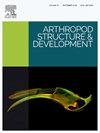奥氏藻属(节肢动物门:螯足纲)卵磷脂营养型后生动物的形态学以及关于繁殖策略的一些说明。
IF 1.3
3区 农林科学
Q2 ENTOMOLOGY
引用次数: 0
摘要
海蜘蛛科(Callipallenidae)希尔顿(Hilton),1942 年,与蛱蝶科(Nymphonidae)其他科一起隶属于蛱蝶超科(Nymphonoidea Pocock),1904 年。卵磷脂营养型后幼体从海蜘蛛的卵中孵化出来,但有关这一生命阶段的数据非常稀少和零碎。这使得人们对幼虫解剖、形态和多样性的了解非常有限。我们首次采用光镜(LM)和扫描电子显微镜(SEM)对 Austropallene bucera Pushkin, 1993、Austropallene calmani Gordon, 1944 和 Austropallene cristata Bouvier, 1911 的幼虫进行了研究和描述。对幼虫和含卵雄性成虫的主要形态参数进行了测定。同时还介绍了后幼体的总平面图及其具体特征。所研究的奥氏囊虫物种的后生幼虫兼具卵磷脂营养型幼虫和自由生活型吡虫幼虫的特征。根据原始数据和已发表的数据,对蛱蝶超科幼虫的多样性进行了分析,并建立了形态学系列。卵磷脂营养幼虫的复合体,如 Callipallenidae 的后生幼虫,应被视为整个超科的主要幼虫。研究还表明,具有卵磷脂营养幼虫的海蜘蛛倾向于遵循 K 战略,但它们对后代的照顾程度各不相同。本文章由计算机程序翻译,如有差异,请以英文原文为准。
Morphology of lecithotrophic postlarvae of genus Austropallene (Arthropoda: Chelicerata) with some notes on reproductive strategy
The family Callipallenidae Hilton, 1942 belongs to the superfamily Nymphonoidea Pocock, 1904 together with other family, Nymphonidae. The lecithotrophic postlarvae hatch from the eggs of the callipallenid sea spiders, but the data on this life stage are very scarce and fragmentary. This gives a very limited understanding of larval anatomy, morphology, and diversity. The larvae of Austropallene bucera Pushkin, 1993, Austropallene calmani Gordon, 1944, and Austropallene cristata Bouvier, 1911 have been studied and described for the first time by the methods of light (LM) and scanning electron microscopy (SEM). The main morphometry parameters have been determined in larvae and adult egg-bearing males. The general plan of the postlarvae is presented together with its specific features. The postlarvae of the studied Austropallene species combine the features of lecithotrophic and free-living pycnogonid larvae. The diversity of larvae in the Nymphonoidea superfamily has been analysed considering original and published data, and a morphological series has been developed. The complex of lecithotrophic larvae, like postlarvae of Callipallenidae, should be considered as primary for the entire superfamily. It is also suggested that sea spiders with lecithotrophic larvae tend to follow the K-strategy, but they care for their offspring to varying degrees.
求助全文
通过发布文献求助,成功后即可免费获取论文全文。
去求助
来源期刊
CiteScore
3.50
自引率
10.00%
发文量
54
审稿时长
60 days
期刊介绍:
Arthropod Structure & Development is a Journal of Arthropod Structural Biology, Development, and Functional Morphology; it considers manuscripts that deal with micro- and neuroanatomy, development, biomechanics, organogenesis in particular under comparative and evolutionary aspects but not merely taxonomic papers. The aim of the journal is to publish papers in the areas of functional and comparative anatomy and development, with an emphasis on the role of cellular organization in organ function. The journal will also publish papers on organogenisis, embryonic and postembryonic development, and organ or tissue regeneration and repair. Manuscripts dealing with comparative and evolutionary aspects of microanatomy and development are encouraged.

 求助内容:
求助内容: 应助结果提醒方式:
应助结果提醒方式:


